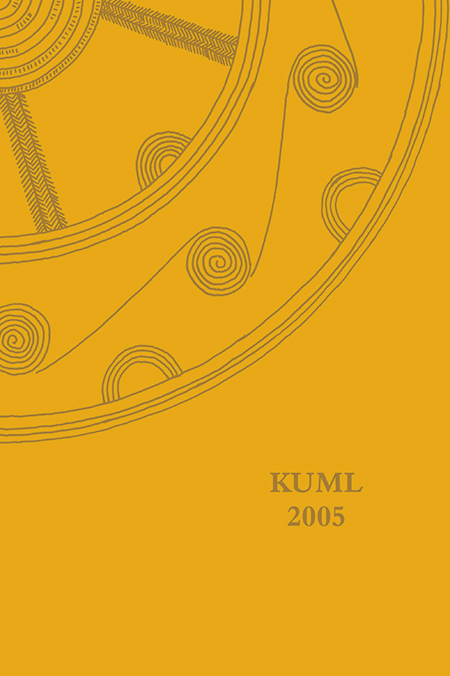Dansk arkæologi i hagekorsets skygge 1933-1945
DOI:
https://doi.org/10.7146/kuml.v54i54.97314Nøgleord:
Dansk arkæologi, 1933-1945Resumé
Danish archaeology in the shadow of the swastika, 1933-1945
With Hitler’s takeover in 1933 and the emergence of the National Socialist regime, Prehistoric archaeology in Germany was strengthened, both on the economical and the scholarly level. Prehistoric archaeologists entered into a Faustian bargain with the new government, and arguing the presence of Germanic peoples outside the borders of the Third Reich, they legitimated the Nazi “Drang nach Osten”. With the Fuhrer’s lack of interest in German prehistory, the fight for control of this field became a matter between two organisations, the Ahnenerbe, which was attached to Heinrich Himmler’s SS, and the competing Reichsbund für Deutsche Vorgeschichte under NSDAP’s chief ideologist, Alfred Rosenberg’s “Amt Rosenberg” (Figs. 1-2). When the Second World War broke out in 1939, Ahnenerbe appeared as winner of the fight over the German prehistory. However, the archaeological power struggles continued in the conquered territories until the end of the war.
Immediately after the Nazi takeover in 1933, leading staff members of the Danish National Museum in Copenhagen, such as Mouritz Mackeprang, Poul Nørlund, and Johannes Brøndsted (Figs. 3-4) dissociated themselves from the political development south of the border. However, in the course of time, and in conformity with the official Danish accommodation policy towards Germany in the 1930s, the opposition changed their attitude into a more neutral policy of cultural adjustment towards Nazified German colleagues.
The Danish government’s surrender on the 9th of April 1940 meant a continuing German recognition of Denmark as a sovereign state. From the German side, the communication with the Danish government was handled by the German ministry of foreign affairs in Berlin, and by the German legation in Copenhagen. Denmark was the sole occupied country under the domain of the ministry of foreign affairs, and from the beginning of the occupation it became a regular element in the policy of the ministry to prevent other political organs within the Nazi polycracy to gain influence in Denmark. Not until the appointment of SS-Gruppenfuhrer Werner Best (Fig. 5) as the German Reich Plenipotentiary in Denmark in November 1942, the SS and the Ahnenerbe got an opportunity to secure their influence in Denmark. However, due to the chilly attitude in the Danish population towards the German culture propaganda, practiced mainly through the German Scientific Institute in Copenhagen, and the gradual worsening of the political conditions following the resignation of the Danish government on the 29th of August 1943, the Ahnenerbe, led by Wolfram Sievers (Fig. 6), was never firmly established in Denmark. The one result of Ahnenerbe’s influence in Denmark worth mentioning was the effort by the Kiel Archaeologist Karl Kersten (Fig. 7) to prevent German destruction of prehistoric Danish (Germanic) relics. Kersten began his work in 1940 and was met from the start with aversion from the National Museum in Copenhagen, which regarded the activities of the Ahnenerbe-archaeologist as German interference with Danish conditions. Yet, in time the work of the Kiel archaeologist was accepted and recognised by the muse- um, and he was officially recognized by the Danish state when in 1957, Kersten was made Knight of Dannebrog.
Less successful than the Ahnenerbe rival was the prominent Nazi archaeologist Hans Reinerth (Fig. 8) and the efforts by Reichsbund für Deutsche Vorgeschichte to gain influence on the Danish scene of culture politics. One of Reinerth’s few successes in occupied Denmark was a short contact with two Danish archaeologists, Gudmund Hatt and Mogens B. Mackeprang (Figs. 9-10). However, the connections with the RfDV-leader do not seem to have been maintained, once the Danish government had ceased to function from the 29th of August 1943.
During the occupation, around 300 listed burial mounds and an unknown number of prehistoric relics below ground level were destroyed or damaged due to construction projects carried out by the German occupants (Figs. 11-12). The complaints about the damage put forward by the National Museum were generally met by understanding in the German administration and in the Bauleitung (construction department), whereas the Wehrmacht had a more indifferent approach to the complaints. As opposed to this, the Danish museums managed to get through the war with no damage or German confiscations worth mentioning, thus avoiding the fate of museums, collections, and libraries in countries such as France, Poland, and the Soviet Union.
Lars Schreiber Pedersen
Århus
Translated by Annette Lerche Trolle
Downloads
Publiceret
Citation/Eksport
Nummer
Sektion
Licens
Fra og med årgang 2022 er artikler udgivet i Kuml med en licens fra Creative Commons (CC BY-NC-SA 4.0).
Alle tidligere årgange af tidsskriftet er ikke udgivet med en licens fra Creative Commons.


